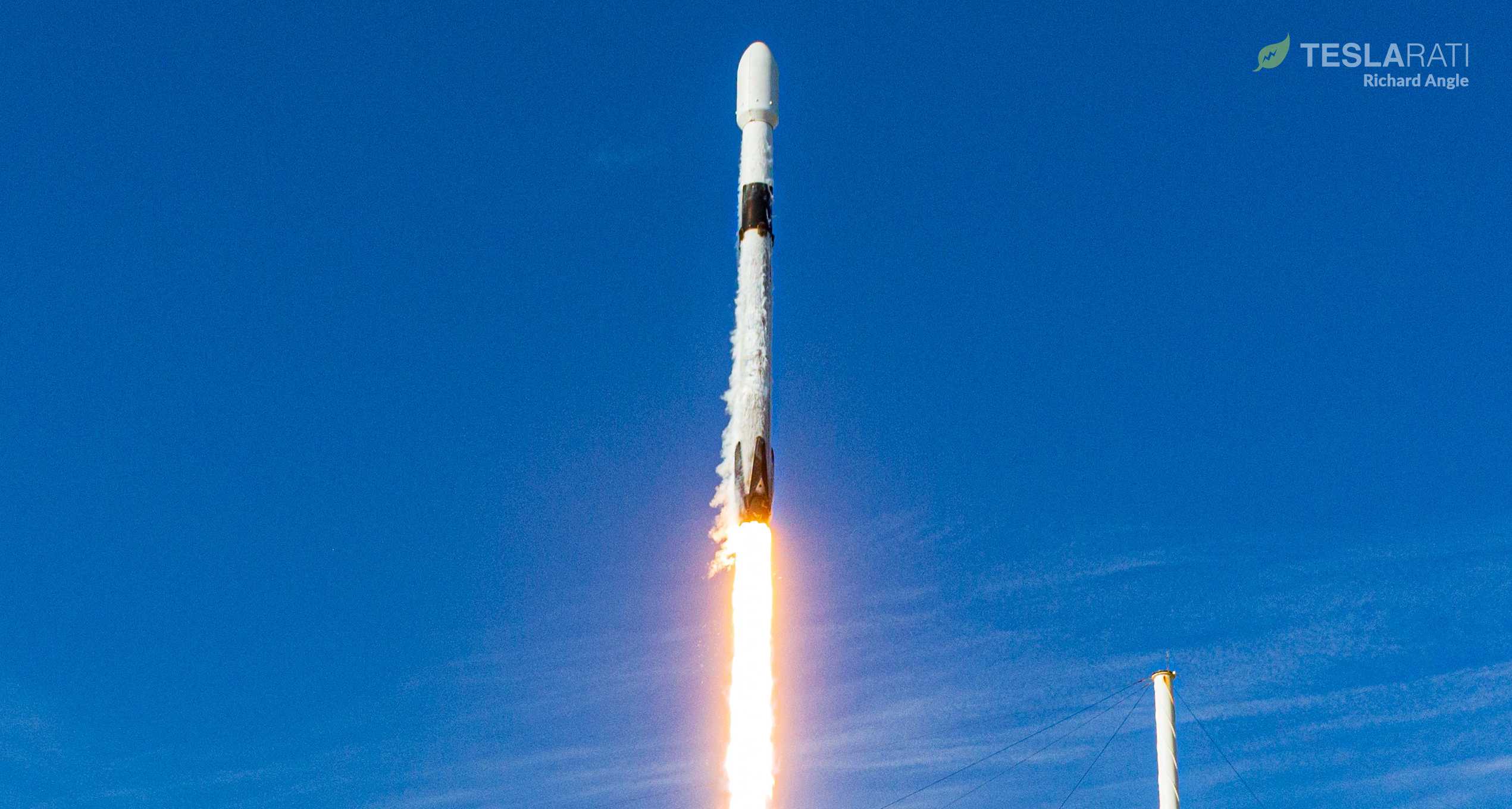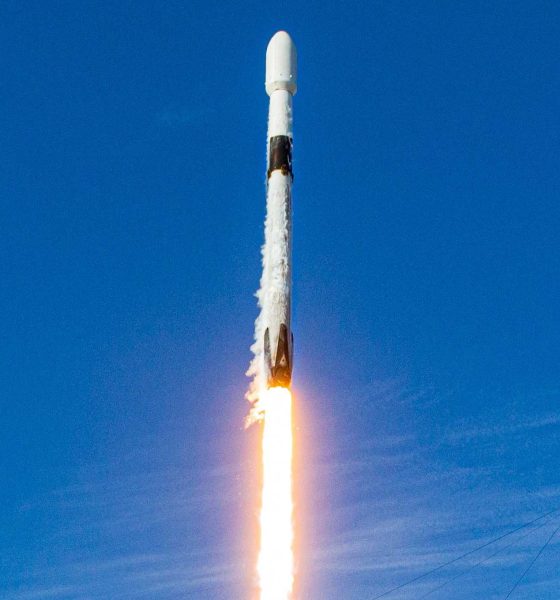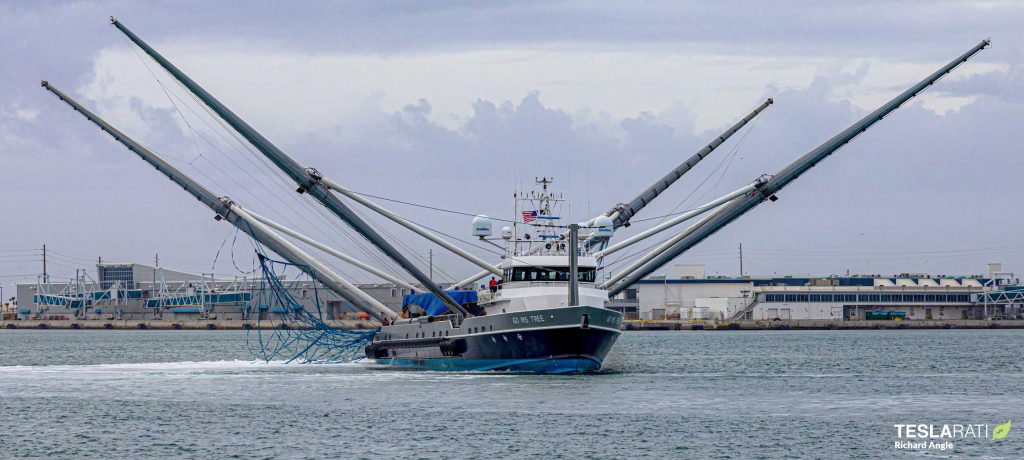

News
SpaceX rocket test-fired for first Starlink launch since in-flight engine failure
Just a month after an automatic launch abort sequence and subsequent in-flight engine failure, the SpaceX Falcon 9 is ready to return to flight. SpaceX’s sixth Starlink V1.0 and seventh overall launch of 60 Starlink satellites – initially expected on April 16th later delayed to April 23rd – will mark the triumphant return of a flight-proven booster.
Early on Thursday, April 16th – a week ahead of the scheduled launch attempt – the flight-proven B1051 Falcon 9 booster fully stacked with the integrated payload of 60 flat-stacked Starlink satellites, rolled out to Launch Complex 39-A at Kennedy Space Center. Just over twenty-four hours later on Friday, April 17th, the rocket and payload were raised into the vertical launching position. At noon on Friday, SpaceX teams conducted a wet dress rehearsal fully fueling the first stage booster with propellant – rocket grade kerosene (RP-1) and liquid oxygen (LOX) – before successfully conducting a full-duration, pre-launch ignition of all nine Merlin 1D engines while holding the rocket in place – called a static fire.
Shortly after the test completion, SpaceX confirmed the targeted Thursday, April 23rd launch attempt scheduled for 3:16 pm EDT from LC-39A via the company’s Twitter account. Along with the launch date, SpaceX confirmed that the upcoming Starlink-6 mission (seventh overall) will be the fourth attempted launch and recovery of booster B1051. This booster previously supported launches from three different launchpads in Florida and California. Perhaps most notably, it supported the successful first uncrewed demonstration mission of the Crew Dragon capsule in March of 2019.
SpaceX also confirmed that the protective nosecone encapsulating the satellite payload, called the payload fairing, is also recovered and reused flight-proven hardware. To date, SpaceX has reused fairing halves twice. Both instances have been conducted on internal Starlink missions, one in November 2019 and the most recent on March 18th’s Starlink-5 mission. Both featured fairing halves that were recovered after landing softly in the water of the Atlantic ocean. Ultimately, only the fairing halves of the most recent March 18th Starlink-5 mission were successfully recovered. The recovery attempt during November’s mission was called off due to rough seas.

According to SpaceX, April 23rd’s upcoming Starlink-6 mission will feature fairing halves recovered from the AMOS-17 mission launched in August of 2019. As previously covered by Teslarati, the mission resulted in a fairing half caught in a large net mounted atop one of the company’s fairing recovery vessels, GO Ms. Tree. The other half was scooped up after a gentle water landing. Starlink-6 will be the first time that a fairing half caught in a net is re-used in conjunction with a half recovered from the water. If the fairing halves perform nominally, as expected, it will help SpaceX to push the envelope of flight-proven hardware reuse even further.
Closely mirroring the Starlink-5 mission, SpaceX will once again launch from LC-39A and utilize a slightly altered mission profile. This will allow the Falcon 9’s second stage to deliver the 60 flat-stack satellites to an elliptical, rather than circular, orbit intended to reduce stress during booster re-entry and landing. Although used with previous missions, this particular mission profile has yet to result in a successful booster recovery.
If successful, Starlink-6 will be the first time a booster lands on the autonomous spaceport drone ship “Of Course I Still Love You” since this boosters last landing in January 2020 following the successful Starlink-4 mission. As of Sunday morning, April 19th, “Of Course I Still Love You” departed Port Canaveral to travel to the recovery zone some 629km downrange ahead of Thursday’s launch attempt. The crew recovery vessel, GO Quest, followed shortly thereafter. The two fairing recovery vessels GO Ms. Tree and GO Ms. Chief are expected to leave port early in the week as the ships are built for speed and will reach the destination much quicker.
Check out Teslarati’s newsletters for prompt updates, on-the-ground perspectives, and unique glimpses of SpaceX’s rocket launch and recovery processes.

Elon Musk
Elon Musk and Tesla AI Director share insights after empty driver seat Robotaxi rides
The executives’ unoccupied tests hint at the rapid progress of Tesla’s unsupervised Robotaxi efforts.

Tesla CEO Elon Musk and AI Director Ashok Elluswamy celebrated Christmas Eve by sharing personal experiences with Robotaxi vehicles that had no safety monitor or occupant in the driver’s seat. Musk described the system’s “perfect driving” around Austin, while Elluswamy posted video from the back seat, calling it “an amazing experience.”
The executives’ unoccupied tests hint at the rapid progress of Tesla’s unsupervised Robotaxi efforts.
Elon and Ashok’s firsthand Robotaxi insights
Prior to Musk and the Tesla AI Director’s posts, sightings of unmanned Teslas navigating public roads were widely shared on social media. One such vehicle was spotted in Austin, Texas, which Elon Musk acknowleged by stating that “Testing is underway with no occupants in the car.”
Based on his Christmas Eve post, Musk seemed to have tested an unmanned Tesla himself. “A Tesla with no safety monitor in the car and me sitting in the passenger seat took me all around Austin on Sunday with perfect driving,” Musk wrote in his post.
Elluswamy responded with a 2-minute video showing himself in the rear of an unmanned Tesla. The video featured the vehicle’s empty front seats, as well as its smooth handling through real-world traffic. He captioned his video with the words, “It’s an amazing experience!”
Towards Unsupervised operations
During an xAI Hackathon earlier this month, Elon Musk mentioned that Tesla owed be removing Safety Monitors from its Robotaxis in Austin in just three weeks. “Unsupervised is pretty much solved at this point. So there will be Tesla Robotaxis operating in Austin with no one in them. Not even anyone in the passenger seat in about three weeks,” he said. Musk echoed similar estimates at the 2025 Annual Shareholder Meeting and the Q3 2025 earnings call.
Considering the insights that were posted Musk and Elluswamy, it does appear that Tesla is working hard towards operating its Robotaxis with no safety monitors. This is quite impressive considering that the service was launched just earlier this year.
Elon Musk
Starlink passes 9 million active customers just weeks after hitting 8 million
The milestone highlights the accelerating growth of Starlink, which has now been adding over 20,000 new users per day.

SpaceX’s Starlink satellite internet service has continued its rapid global expansion, surpassing 9 million active customers just weeks after crossing the 8 million mark.
The milestone highlights the accelerating growth of Starlink, which has now been adding over 20,000 new users per day.
9 million customers
In a post on X, SpaceX stated that Starlink now serves over 9 million active users across 155 countries, territories, and markets. The company reached 8 million customers in early November, meaning it added roughly 1 million subscribers in under seven weeks, or about 21,275 new users on average per day.
“Starlink is connecting more than 9M active customers with high-speed internet across 155 countries, territories, and many other markets,” Starlink wrote in a post on its official X account. SpaceX President Gwynne Shotwell also celebrated the milestone on X. “A huge thank you to all of our customers and congrats to the Starlink team for such an incredible product,” she wrote.
That growth rate reflects both rising demand for broadband in underserved regions and Starlink’s expanding satellite constellation, which now includes more than 9,000 low-Earth-orbit satellites designed to deliver high-speed, low-latency internet worldwide.
Starlink’s momentum
Starlink’s momentum has been building up. SpaceX reported 4.6 million Starlink customers in December 2024, followed by 7 million by August 2025, and 8 million customers in November. Independent data also suggests Starlink usage is rising sharply, with Cloudflare reporting that global web traffic from Starlink users more than doubled in 2025, as noted in an Insider report.
Starlink’s momentum is increasingly tied to SpaceX’s broader financial outlook. Elon Musk has said the satellite network is “by far” the company’s largest revenue driver, and reports suggest SpaceX may be positioning itself for an initial public offering as soon as next year, with valuations estimated as high as $1.5 trillion. Musk has also suggested in the past that Starlink could have its own IPO in the future.
News
NVIDIA Director of Robotics: Tesla FSD v14 is the first AI to pass the “Physical Turing Test”
After testing FSD v14, Fan stated that his experience with FSD felt magical at first, but it soon started to feel like a routine.

NVIDIA Director of Robotics Jim Fan has praised Tesla’s Full Self-Driving (Supervised) v14 as the first AI to pass what he described as a “Physical Turing Test.”
After testing FSD v14, Fan stated that his experience with FSD felt magical at first, but it soon started to feel like a routine. And just like smartphones today, removing it now would “actively hurt.”
Jim Fan’s hands-on FSD v14 impressions
Fan, a leading researcher in embodied AI who is currently solving Physical AI at NVIDIA and spearheading the company’s Project GR00T initiative, noted that he actually was late to the Tesla game. He was, however, one of the first to try out FSD v14.
“I was very late to own a Tesla but among the earliest to try out FSD v14. It’s perhaps the first time I experience an AI that passes the Physical Turing Test: after a long day at work, you press a button, lay back, and couldn’t tell if a neural net or a human drove you home,” Fan wrote in a post on X.
Fan added: “Despite knowing exactly how robot learning works, I still find it magical watching the steering wheel turn by itself. First it feels surreal, next it becomes routine. Then, like the smartphone, taking it away actively hurts. This is how humanity gets rewired and glued to god-like technologies.”
The Physical Turing Test
The original Turing Test was conceived by Alan Turing in 1950, and it was aimed at determining if a machine could exhibit behavior that is equivalent to or indistinguishable from a human. By focusing on text-based conversations, the original Turing Test set a high bar for natural language processing and machine learning.
This test has been passed by today’s large language models. However, the capability to converse in a humanlike manner is a completely different challenge from performing real-world problem-solving or physical interactions. Thus, Fan introduced the Physical Turing Test, which challenges AI systems to demonstrate intelligence through physical actions.
Based on Fan’s comments, Tesla has demonstrated these intelligent physical actions with FSD v14. Elon Musk agreed with the NVIDIA executive, stating in a post on X that with FSD v14, “you can sense the sentience maturing.” Musk also praised Tesla AI, calling it the best “real-world AI” today.








